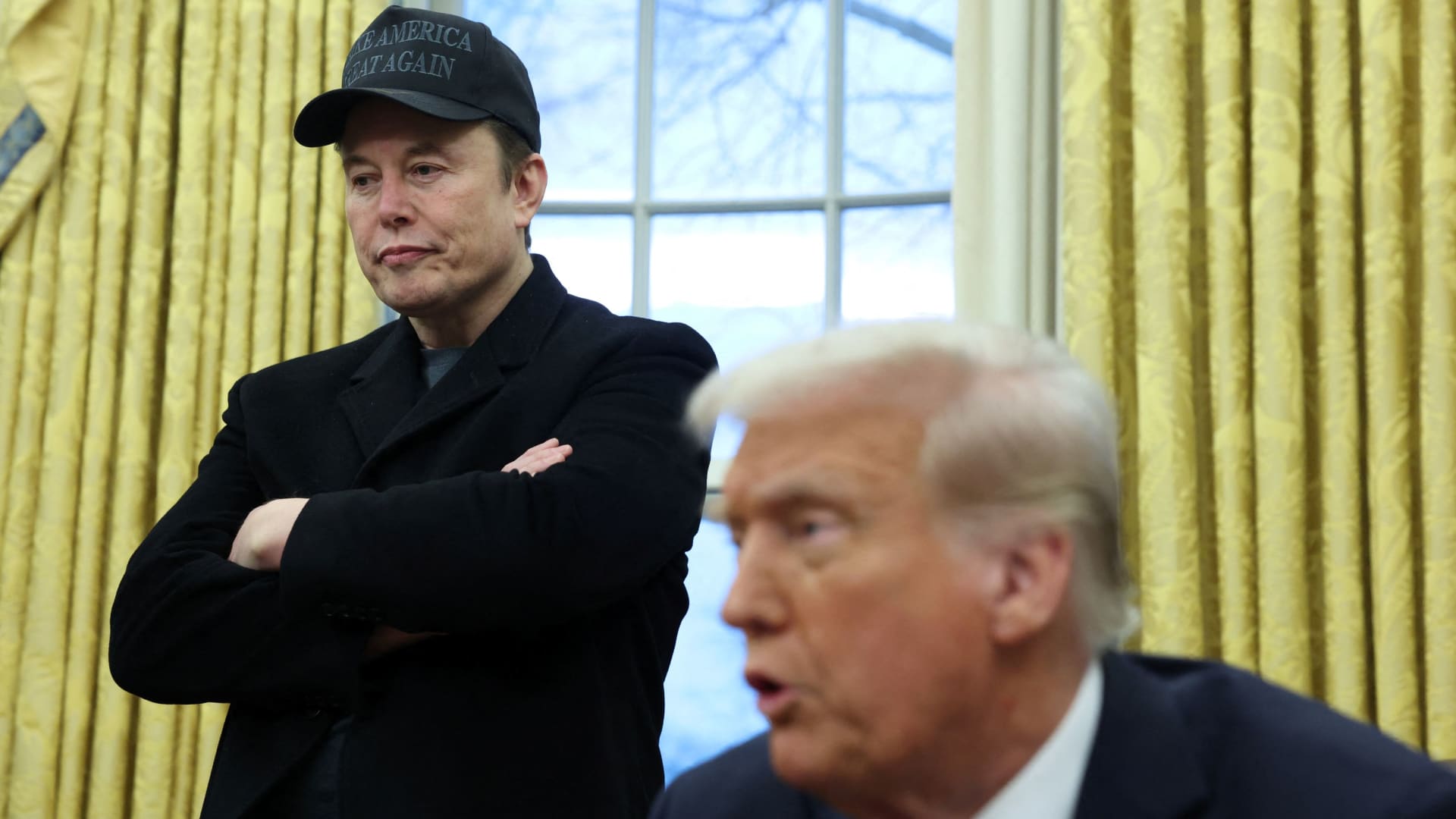Elon Musk listens to U.S. President Donald Trump speak in the Oval Office of the White House in Washington, D.C., U.S., Feb. 11, 2025.
Kevin Lamarque | Reuters
President Donald Trump’s moves to fire thousands of federal government workers have coincided with a surge in jobless claims in Washington D.C. that could get worse as the efforts intensify.
Since Trump has taken office, nearly 4,000 workers in the city have filed for unemployment insurance as part of a surge that began at the start of the new year, according to Labor Department figures not adjusted for seasonal factors.
In all, just shy of 7,000 claims have been filed in the six weeks of the new year, or about 55% more than in the prior six-week period. Filings rose to 1,780 for the week ending Feb. 8, a 36% increase from the prior week and more than four times around the same period in 2024.
By contrast, the total level of claims in the U.S. has been moving little, with the four-week moving average of initial claims at 216,000, little changed from the beginning of the year and actually trending lower for the most part over the past several months.
The jump in D.C. claims come as Trump and the Elon Musk-led Department of Government Efficiency advisory board have ordered layoffs across the government structure and instituted buyout programs for early retirement.
“I expect it to go higher, and definitely we’ll be watching it very closely,” said Raj Namboothiry, senior vice president at Manpower North America, the workforce solutions company.
While it’s unclear what share of the spike is directly related to federal government workers, the rise coincides with the White House ordering the layoffs of probationary employees along with thousands of others as the administration seeks a broad-based reduction in the labor force. In addition, some 75,000 employees have accepted the buyout offer.
Washington D.C. had one of the highest unemployment rates in the country at 5.5% as of December 2024, surpassed only by Nevada, according to the Bureau of Labor Statistics. However, the metropolitan area including the Arlington and Alexandria, Va., area was at just 2.7%. The national unemployment rate for the month was 4.1%, before slipping to 4% in January.
Broader labor picture still solid
Namboothiry said the reduction of the federal workforce could present some problems in the region, though it would do little to dent a national picture that he called “fairly stable.”
“Yes, the numbers are definitely sizable,” he said. “But because you’re spread across multiple [geographies], multiple skill sets, multiple sectors, I don’t see that playing a significant role in impacting the overall market.”
There are about about 2.4 million federal workers, excluding post office employees, with nearly one-fifth employed in the D.C. area and the others spread around the country. Outside of spikes around tax season, the number has held fairly constant since the late 1960s.
Still, Trump has targeted the federal employment rolls as a major part of his effort to shrink the size of government.
Displaced employees may not be out of work long, however. Namboothiry thinks their skill sets could be in high demand for certain sectors of the economy.
“This presents an opportunity, because there are clients who are looking for talent that’s exiting that may benefit,” he said. “There’s going to be some conversations around an interest from employers with this pool of talent.”
The cuts that Trump are targeting are spread around the government, with some agencies expecting dramatic cutbacks.
How those displaced employees fare will depend on their fields of work, said Allison Shrivastava, economist at the Indeed Hiring Lab.
“It might be that very few of them remain without work,” she said. “It definitely depends on sector. So for example, if you are, As Trump ramps up layoffs, unemployment claims start to spike in Washington, D.C. you’re in the accounting sector right now, that’s a sector that, in terms of job postings, we’ve seen perform pretty well. Say you’re in software development … those jobs have not been as in demand. The level of difficulty that you would have in finding a job would really be contingent on the sector that you’re in.”

 Accounting1 week ago
Accounting1 week ago
 Economics1 week ago
Economics1 week ago
 Personal Finance1 week ago
Personal Finance1 week ago
 Accounting1 week ago
Accounting1 week ago
 Finance1 week ago
Finance1 week ago
 Economics1 week ago
Economics1 week ago
 Economics1 week ago
Economics1 week ago
 Economics1 week ago
Economics1 week ago





















